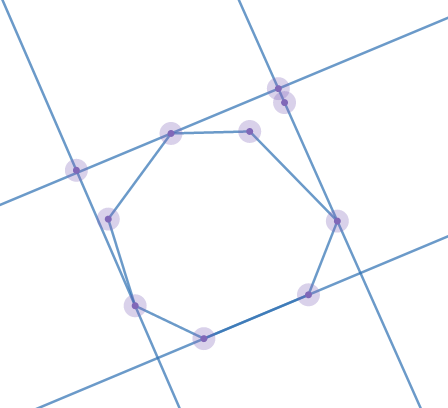1
2
3
4
5
6
7
8
9
10
11
12
13
14
15
16
17
18
19
20
21
22
23
24
25
26
27
28
29
30
31
32
33
34
35
36
37
38
39
40
41
42
43
44
45
46
47
48
49
50
51
52
53
54
55
56
57
58
59
60
61
62
63
64
65
66
67
68
69
70
71
72
73
74
75
76
77
78
79
80
81
82
83
84
85
86
| #include<bits/stdc++.h>
#define double long double
#define eps 1e-18
using namespace std;
const int maxn=5e4+10;
struct geometric {
double x, y;
geometric(double X=0, double Y=0) :x(X), y(Y) {}
friend geometric operator + (const geometric a, const geometric b) { return geometric(a.x+b.x, a.y+b.y); }
friend geometric operator - (const geometric a, const geometric b) { return geometric(a.x-b.x, a.y-b.y); }
friend geometric operator * (const geometric a, double p) { return geometric(a.x*p, a.y*p); }
friend geometric operator / (const geometric a, double p) { return geometric(a.x/p, a.y/p); }
}p[maxn], st[maxn];
int n, cnt, top;double S=1e20;
double dis(geometric a, geometric b) { return sqrt((a.x-b.x)*(a.x-b.x)+(a.y-b.y)*(a.y-b.y)); }
double dot(geometric a1, geometric a2, geometric b1, geometric b2) { return (a2.x-a1.x)*(b2.x-b1.x)+(a2.y-a1.y)*(b2.y-b1.y); }
double cross(geometric a1, geometric a2, geometric b1, geometric b2) { return (a2.x-a1.x)*(b2.y-b1.y)-(a2.y-a1.y)*(b2.x-b1.x); }
bool cmp(geometric a, geometric b)
{
double tmp;
tmp=cross(p[1], a, p[1], b);
if(tmp>0)return true;
if(tmp==0)return dis(p[1], a)<=dis(p[1], b);
return false;
}
int main()
{
while(true)
{
memset(st,0,sizeof(st));
memset(p,0,sizeof(p));
scanf("%d", &n);
if(n==0)break;
top=0;cnt=0;S=1e20;
for(int i=1;i<=n;i++)
{
double x, y;
scanf("%Lf%Lf", &x, &y);
p[++cnt]=geometric(x, y);
if(i==1)
continue;
if(p[cnt].y<p[1].y)
swap(p[cnt], p[1]);
if(p[cnt].y==p[1].y&&p[cnt].x>p[1].x)
swap(p[cnt], p[1]);
}
sort(p+2, p+cnt+1, cmp);
st[++top]=p[1];
for(int i=2;i<=cnt;i++)
{
while(top>1&&cross(st[top-1], st[top], st[top], p[i])<=0)
top--;
st[++top]=p[i];
}
st[++top]=p[1];
if(top<=3)
{
printf("0.0000\n");
continue;
}
st[0]=st[top-1];
for(int i=2, j=3,l,r;i<=top;i++)
{
r=(i==top)?1:i;l=i-1;
while(cross(st[i-1], st[i], st[i], st[j])<cross(st[i-1], st[i], st[i], st[j+1]))
j=(j==top-1)?1:j+1;
while(dot(st[i-1], st[i], st[i], st[r])<dot(st[i-1], st[i], st[i], st[r+1]))
r=(r==top-1)?1:r+1;
while(dot(st[i], st[i-1], st[i-1], st[l])<dot(st[i], st[i-1], st[i-1], st[l-1]))
l=(l==1)?top-1:l-1;
double wide, high, len=dis(st[i-1], st[i]);
wide=fabs(dot(st[i], st[i-1], st[i-1], st[l]))/len+fabs(dot(st[i-1], st[i], st[i], st[r]))/len+len;
high=fabs(cross(st[i-1], st[i], st[i-1], st[j]))/len;
S=min(S, high*wide);
}
printf("%.4Lf\n", S);
}
return 0;
}
|
